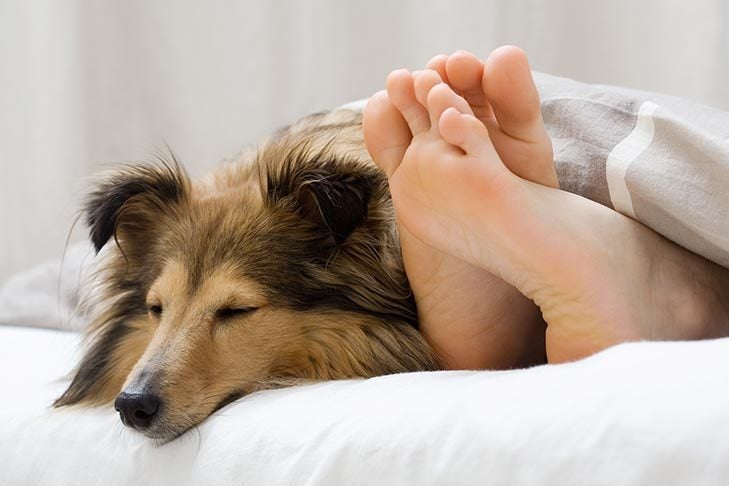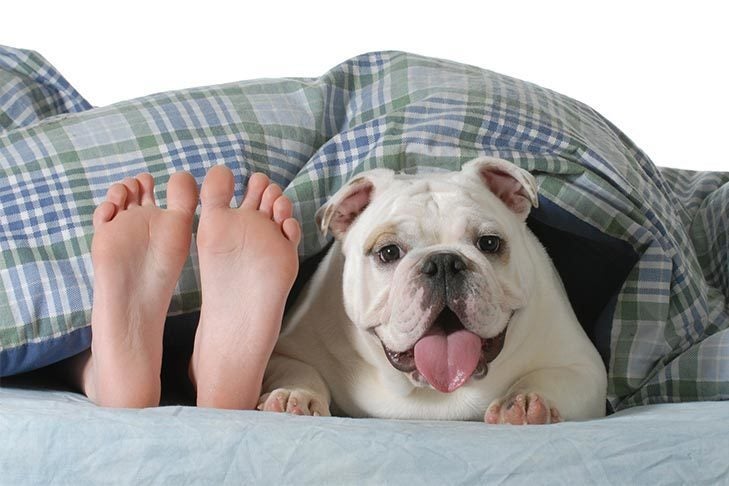
Like toddlers, dogs can be difficult to keep out of your bed. Many dogs desire physical proximity to their owners at all possible times. Plenty of pup owners consider the feeling mutual, so many end up allowing their dogs in the bed to sleep at night.
Not everybody agrees, namely those who feel dogs should sleep in a crate or even out of the room altogether. Naturally, however, members from each side of this argument eventually cross paths, become a couple, and disagree about where the dog should sleep. So if you’re in dog-in-the-bed camp, but your partner isn’t, or vice versa, how do you resolve this issue?
Address Hygiene Around A Dog In The Bed
First, you need to determine what is your partner’s true objection. Some people believe that having a dog in the bed is unhygienic, but Dr. Joel Gavriele-Gold, clinical psychologist and author of the book When Pets Come Between Partners, insists that hygiene isn’t the real issue.
Instead of succumbing to the hygiene argument, he advises breaking it down. What does your partner mean by unhygienic? Do they mean really simply dirty, infected, or infested? True, dogs can get sweaty from playing at the park, or sandy from the beach, or muddy from a hike. But, as with a dirty child, the solution may be simple.
“If you want the dog in the bed and the dog is dirty, give it a bath,” says Dr. Gavriele-Gold. “Germs are a different issue. Unless the dog has some kind of skin thing going on, dogs are not transmitting any diseases.”
Refer To Sleep Studies
Those opposing sharing beds with dogs might cite the argument that dogs disturb our sleep. In reality, however, dogs may improve sleep habits, especially for those who have trouble falling asleep or live in colder climates. Your pup’s calm, deep breathing syncs to yours to become meditative and mindful. And their body temperature, which is three-to-six degrees above humans, really can keep you warm. Of course, any time you add another body to a bed, whether it’s a toddler or a puppy, the potential for sleep disturbance exists.

“Sleep issues could be compounded, in which case the dog loses. The dog is out,” Dr. Gavriele-Gold says.
But if your partner is only worrying about sleep inefficiency rather than experiencing it, you can point to a 2017 study by the Mayo Clinic. The clinic studied 40 adult dogs and their owners, each outfitted with devices that tracked movements and sleep/wake cycles. They concluded that even when dogs woke up their owners (and admittedly, they did), the outcome was trivial. People who allowed their dogs to sleep on the bed, or in the bedroom, achieved a satisfactory sleep score of 80–83 percent.
Let’s Talk About Sex
Ask any sexually active couple who has had a dog on the bed during an encounter, and you’ll hear an amusing anecdote. But it’s usually only amusing in the retelling. Many partners do not find it funny when an animal decides to participate during lovemaking sessions. In fact, it’s a real fear.
“Some people are afraid the dog is watching or they’re afraid the dog will interfere. I think it’s very significant,” Dr. Gavriele-Gold says. “It requires considerable discussion by the couple. I often suggest ‘dog-free evenings’ if both people are feeling like it might be a sexy evening. Objections to having the dog in bed may have much more to do with how two people feel about sex and more particularly about sex with each other. Having sex or the lack of may indicate that what is really going on the relationship is deeper and probably not being talked about.”
Sometimes Your Partner Is Correct
Puppies, seniors, or sick dogs who can’t make it through the night without urinating shouldn’t have a place between your pillows. Nor should pups who are naturally reactive when woken suddenly. Most dogs know their place within the household, but a rocky time for testing that place is when new humans, especially babies, enter the picture. Some dogs might resent the intrusion of a new body and the perceived, or real, threat of loss of attention and affection. Plus, it could get a little crowded.
If you do decide to remove a dog that’s accustomed to sleeping in a bed with you, first transition the dog to the floor, then outside of the room. To keep the dog in the room, try crate-training them, or giving them an elevated position equal to the bed so they can survey the room similarly. Many breeds also prefer diving under the covers for the warmth, so provide blankets or position a new bed or crate near a source of heat.

When You Can’t Agree About A Dog In The Bed
If none of the above scenarios get at the real issue, then there is a good chance that it’s not actually about the dog.
“Two people who don’t agree on having the dog on the bed need to resolve the conditions in which they would have the dog on the bed—if it’s sometimes or never,” says Dr. Gavriele-Gold. “If it’s never, it may really be about something else. You need to look underneath the surface complaint for what’s really going on.”
‘No Bones About It’ is a monthly relationship column about the ways dogs impact human connections. Dr. Gavriele-Gold’s latest book on dog-human relationships, When Pets Come Between Partners, is now available on Amazon. He also hosts a monthly “Comfort Conversation” on grief on the AKC Pet Loss Support Group on Facebook.

